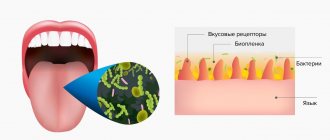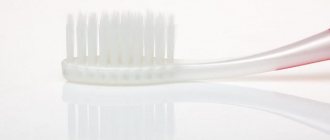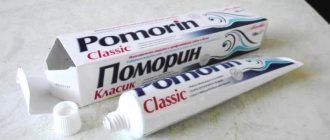Types of halitosis
- Physiological . This type of halitosis is associated with the physiological characteristics of the oral cavity and the predominantly putrefactive composition of the microflora of plaque on the back of the tongue. In this case, teeth and gums can be completely healthy.
- Pathological . In this case, the cause of bad breath may be various inflammations in the oral cavity or diseases of the internal organs.
- Pseudogalithosis . With this type of halitosis, there is a slight odor from the mouth, which is almost not felt by others, but bothers the patient himself. These cases are typical for people who suffered from true halitosis, successfully treated it, but continue to worry about bad breath.
Up to contents
The key to fresh breath is hygiene
It is imperative to pay attention to the condition of the oral cavity. Maybe the child is too lazy to brush his teeth, or he does it just for show, without thoroughly cleaning the gums and interdental space. Therefore, in this case, it is possible that the baby has developed and is developing caries, and the appearance of the smell is connected precisely with this.
You need to take care of your oral cavity as soon as your baby gets his first teeth. Colonies of pathogenic microorganisms develop well in a poorly cleaned oral cavity.
Take a good look at the condition of the oral mucosa - mothers are sometimes able to detect signs of stomatitis or other inflammations.
There can be a lot of food debris left on the mucous membrane of the tongue and parents should not forget about this. Very young children need to regularly clean their tongues of plaque; as they grow older, you need to teach them to do this on their own.
Causes of bad breath
Local reasons
- Dental problems . One of the causes of bad breath is dental caries and its complications. In the cavities formed when teeth decay, food particles accumulate and bacteria actively multiply, which causes a stale odor.
- Gum diseases . Inflammation of the gums and oral mucosa can also cause halitosis.
- Insufficient oral hygiene . Insufficient care of teeth, gums, tongue, as well as orthodontic and orthopedic structures (prostheses, appliances, mouthguards, etc.) is a common cause of bad breath. As a result of neglect of daily hygiene, food particles accumulate between the teeth, on the back of the tongue, near the gums and on the elements of the denture, which become a favorable environment for the growth of bacteria. During the life of these microorganisms, highly volatile sulfur compounds are released, causing bad breath.
- Dry mouth syndrome . This syndrome is a common cause of bad breath. Due to the fact that saliva is produced slowly and in small quantities, the processes of natural cleansing of the oral cavity are disrupted and a breeding ground is created for the proliferation of pathogenic bacteria. Dry mouth can be caused by: diseases of the salivary glands,
- diabetes mellitus,
- vitamin deficiency,
- radiation damage,
- botulism,
- taking certain medications.
Common reasons
- Nutritional pattern . The development of bad breath is promoted by eating protein-rich meat and dairy products. During their processing, alkaline compounds are formed that change the acid-base balance in the oral cavity. At the same time, microorganisms begin to actively multiply, causing bad breath. Eating foods containing large amounts of carbohydrates, on the contrary, helps reduce the intensity of the odor.
- Somatic diseases . The appearance of an unpleasant odor is caused by: some diseases of the digestive system,
- liver pathology, severe lung diseases,
- pathology of ENT organs.
Up to contents
Preventive measures
To promptly prevent the appearance of halitosis in your baby, you must follow a few simple rules:
- Brush your baby's teeth thoroughly twice a day, starting when the first tooth emerges. It is necessary to teach your child how to use a brush and toothpaste correctly to remove plaque from the surface of the teeth.
- Adhere to the age-specific nutrition system, introduce vegetables, fruits, and foods rich in phosphorus and calcium into your child’s diet.
- Eliminate sugar, chocolate, and other sweets from your diet and replace them with honey.
- Give your child plenty of fluids, especially drinking water.
- Visit your dentist regularly to prevent the development of caries.
»
How to identify bad breath
Spoon or napkin test.
With a spoon. The plaque is removed from the back third of the tongue using a plastic spoon. After 1 minute, the smell is assessed by the patient himself or a trusted person conducting the test.
With a napkin. You can also use a sanitary napkin to remove plaque from the back of your tongue. To do this, stick it out as far as possible, holding it by the tip. The back third of the tongue is wiped with a clean napkin and its smell is assessed after 40-45 seconds. The results of such a test make it possible not only to identify halitosis, but also to determine the source of the microorganisms that provoke it - plaque on the back of the tongue.
Dental floss test.
The spaces between the upper and lower molars are cleaned with unscented and unwaxed dental floss.
Then they look at what color the used section of thread was dyed. A yellow tint indicates the presence of plaque, a red tint indicates bleeding gums. Both signs are factors that contribute to the development of halitosis.
30-40 seconds after cleaning the interdental space, the smell of the floss is assessed.
Organoleptic measurement of breath odor.
The dentist assesses the intensity and nature of bad breath. To obtain accurate test results on the eve of the test, the patient and the researcher should refrain from taking antimicrobial drugs, eating spicy foods, seasonings, onions and garlic (2 days before the test), and using scented cosmetics (one day before the test). For 12 hours before the measurement, the patient should not smoke, brush his teeth, use mouthwash, breath fresheners or chewing gum.
Up to contents
Causes not related to diseases
It happens that an absolutely healthy person develops a metallic taste in the mouth. The reason for this may be heavy metal poisoning at work, dehydration, addiction to dietary supplements or taking vitamins.
A person himself is able to identify the etiology in this case if he traces the cause-and-effect relationship of being, for example, in a paint factory workshop with the appearance of a metallic taste in the mouth. You just need to be more attentive to your body and not abuse dietary supplements.
We also must not forget that metal ions can enter the body through the skin, so an iron taste in the mouth may appear as a result of constant skin contact with iron, for example, as a result of working with it or when wearing metal jewelry such as chains and bracelets.
A metallic taste may occur as a result of eating it. It comes from old water pipes or metal utensils. To identify this reason, it is enough to let tap water sit in a glass cup for several hours and see if sediment has formed at the bottom. It’s better to avoid metal utensils altogether.
How to eliminate bad breath
Regular oral hygiene. Regular oral care is one of the main ways to combat unpleasant odor. To fix the problem you need to:
- brush your teeth at least 2 times a day;
- Use floss or mouthwash after every meal. LISTERINE® rinses will do an excellent job of eliminating unpleasant odors;
- clean the tongue of plaque, which is a breeding ground for the proliferation of microorganisms.
Elimination of dental problems. Since the cause of unpleasant odor can be various inflammations in the oral cavity and dental problems, you should regularly visit the dentist for timely detection of diseases and their treatment. The doctor carefully examines the mucous membrane, periodontium and teeth, and examines the ducts of the salivary glands. If necessary, professional sanitation of the oral cavity is carried out, including removal of plaque and tartar, treatment of caries and its complications, elimination of foci of infection, etc. Sometimes it may be necessary to replace dentures with new ones that meet modern dental standards.
Correction of diet. It is recommended to eliminate from the diet foods that cause bad breath: onions, garlic, peppers, cheeses, salami, etc. They contain cysteine, which with the participation of microorganisms is converted into hydrogen sulfide. The latter often causes bad breath.
Rejection of bad habits. To eliminate the unpleasant odor, it is recommended to stop smoking and drinking alcoholic beverages.
Up to contents
How to get rid of bad odor: folk remedies
You can remove bad breath on your own if the symptom is caused by external factors - dietary errors, poor oral hygiene, bad habits. The use of traditional methods must be agreed with a doctor; self-medication should not be practiced.
- Drinking regimen
- the simplest thing for fresh breath is to drink enough water. Dry mouth promotes the proliferation of pathogenic microflora, which produces an unpleasant odor. - Balanced nutrition
- a healthy diet includes foods high in vitamins, minerals, and microelements. Minimizing simple carbohydrates (baked goods, sweets), aromatic foods (raw onions, garlic), legumes, spices, coffee, and alcohol will help make your breath fresher. It is recommended to introduce more apples, carrots, broccoli, and fermented milk products (ryazhenka, kefir, yogurt reduce the level of hydrogen sulfide, hard cheese reduces the acidity of food). - Mouth rinse
- using decoctions of medicinal herbs (mint, fennel, chamomile), special rinses helps remove food debris, prevents gingivitis, and freshens breath. - Cleaning the tongue
- bacteria that cause bad odor accumulate not only on the teeth, but in the hollows and cracks of the tongue, so it needs to be cleaned daily with special scrapers and brushes.
Home methods of combating bad breath will perfectly complement self- and professional hygiene. Simple measures will help eliminate the cause of the bad odor and avoid the development of a serious illness.
Many patients are interested in how to get rid of bad breath and quickly freshen their breath. The following methods will help:
- brushing teeth with a paste with a pronounced aromatic effect (ice mint, menthol);
- using a refresher (mouthwash, active oxygen spray, mouth foam);
- chewing parsley, dill, cloves, cardamom, ginger;
- use of pepper, mustard, and other hot spices in dishes.
Such measures will not help in the treatment of halitosis, but they can temporarily eliminate the bad smell before important negotiations, meetings, or dates.
Treatment of bad breath
Treatment of the underlying disease. Sometimes halitosis is a symptom of some systematic disease of the body. Bad breath can occur when:
- dysfunction of the gastrointestinal tract,
- renal and liver failure,
- ENT diseases,
- problems with the bronchopulmonary system, etc.
In this case, to eliminate halitosis, the underlying disease is diagnosed and treated (conservative, physiotherapeutic, etc.).
Up to contents
Diabetes
Diabetes mellitus is characterized by a violation of the absorption of glucose by the body's cells, which ultimately accumulates in the blood, causing the destruction of the walls of blood vessels in all internal organs and skin.
It is this manifestation of diabetes that can cause a taste of blood in the mouth. That is, the thinnest vessels of the mucous membrane of the mouth and gums burst and bleed. Symptoms of diabetes include constant thirst and long-lasting wounds. If a person experiences all of these manifestations at once, he needs to urgently undergo examination by a doctor and receive a referral for treatment. Otherwise, it may end in diabetic coma and death.
Treatment of dental diseases
- filling teeth affected by caries,
- tooth extraction if treatment is impossible,
- treatment of inflammatory gum diseases.
Use of local medicines. Today there is a wide range of products that help get rid of bad breath:
- toothpastes,
- dental gels,
- lozenges, etc.
Before using them, you should consult your doctor.
Up to contents











